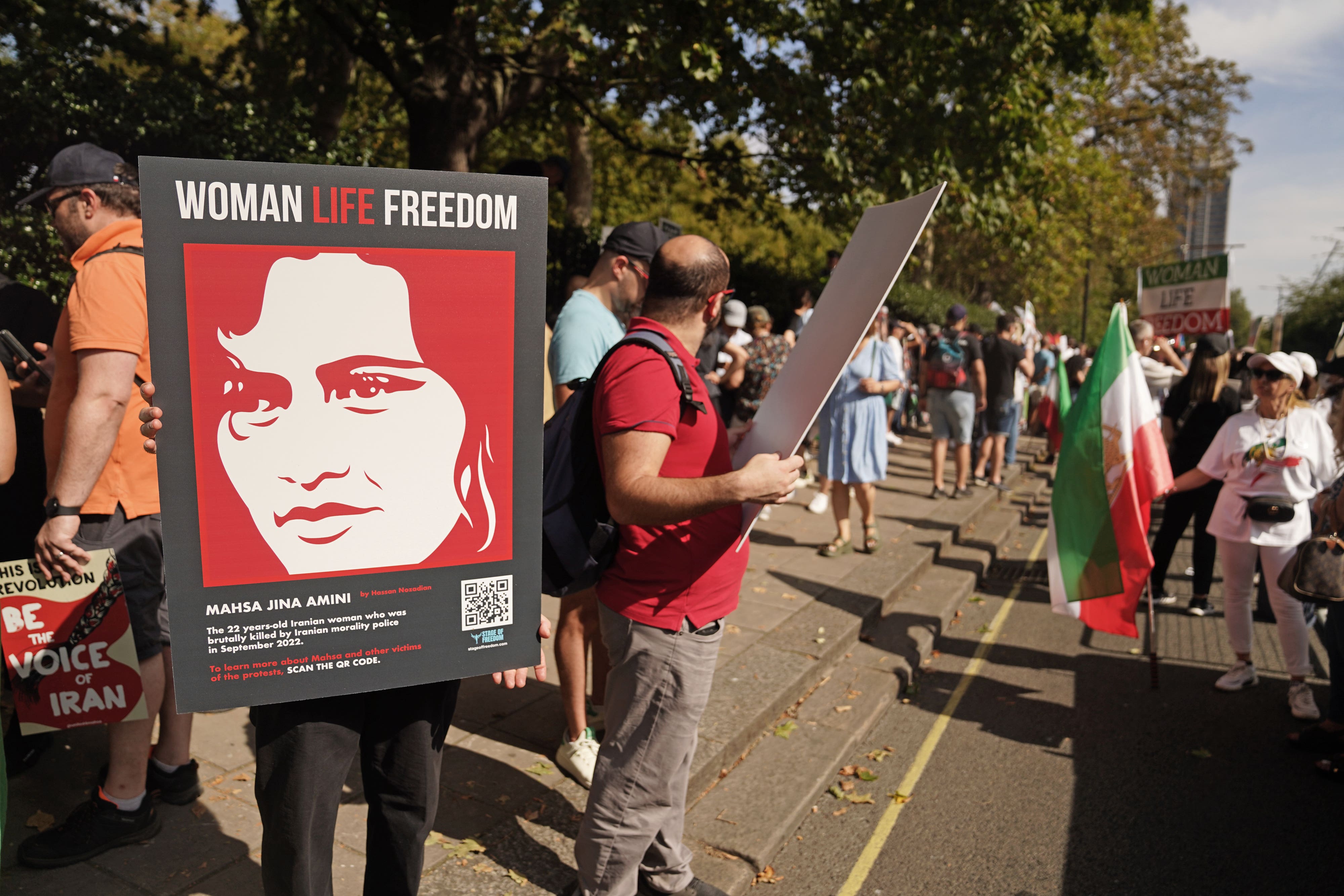Protesters mark anniversary of death of Iranian student Mahsa Amini
Iranian officials claimed she suffered a heart attack in her cell.

Your support helps us to tell the story
From reproductive rights to climate change to Big Tech, The Independent is on the ground when the story is developing. Whether it's investigating the financials of Elon Musk's pro-Trump PAC or producing our latest documentary, 'The A Word', which shines a light on the American women fighting for reproductive rights, we know how important it is to parse out the facts from the messaging.
At such a critical moment in US history, we need reporters on the ground. Your donation allows us to keep sending journalists to speak to both sides of the story.
The Independent is trusted by Americans across the entire political spectrum. And unlike many other quality news outlets, we choose not to lock Americans out of our reporting and analysis with paywalls. We believe quality journalism should be available to everyone, paid for by those who can afford it.
Your support makes all the difference.Protesters in London have campaigned against the Iranian regime, a year after the death of student Mahsa Amini.
The 22-year-old died in police custody on September 16, 2022, three days after being jailed for not wearing her mandatory headscarf correctly.
Iranian officials claimed she suffered a heart attack in her cell.
Watched by a heavy police presence, the protesters outside the Iranian Embassy – who shouted “Woman, life, freedom”, “Down with the regime” and urged the crowds to “say her name” – do not believe them.
Ms Amini’s family have publicly disputed her cause of death, pointing out she was healthy with no history of heart issues and accused Iranian police of beating their loved one to death.
This claim triggered a nationwide uprising that lasted weeks immediately after her death, and Ms Amini became a symbol for the modern Iranian protest movement.
On Saturday, a march from the Iranian Embassy to a rally in Trafalgar Square was among the protests which took place in the capital, and globally, to mark the first anniversary of her death.
Similar protests took place in Italy, Germany and France.
Recalling Ms Amini’s death, Elham Karimpour, a 31-year-old protester at the London demonstration, said: “It is not the first time and if we do not topple the regime, it will not be the last time. Iranians nationwide and globally were not surprised – they were just heartbroken.”
Ms Karimpour was among a number of women of Iranian/British women who took part in demonstrations in London, but because of their links their Middle East homeland, did not feel free to give their full details.
She said: “We have come out because we want to free Iran so the next generation are able to be free, so they can have freedom of speech, freedom of expression and so that women can be able to freely dance in the street because at the moment they can not.
“It is so they can freely sing, because now they can not.”
Protester Saba Arsin, 28, said: “We are here to amplify the voices of all the people in Iran because we are not able to hear their voices in the way that we should.”
She feels that nations should stop negotiating with the Iranian regime.
A 32 year-old woman, who would only give her name as Azadeh, said of Ms Amini’s death: “To be honest I could expect anything from that regime. You get shocked at what they do, but you come to expect it.
“I have lived there and seen how they treat women.
“I have hope that this demonstration will result in democracy because protest has been in all regions and cities in Iran. Everyone is fighting for this revolution.
“Of course, the people we are dealing with (in the regime) have powers, but I have to believe it will change.”
After Ms Amini’s death, the government called on Iran’s security officials to bring the public to heel, which saw more than 500 people killed. Officers also detained more than 22,000 people as they called for justice for Ms Amini.
Ms Amini became a symbol for the modern Iranian protest movement. The uprising was one of the largest challenges to Iran’s theocracy since the 1979 Islamic Revolution.
Cheers broke out when the marchers reached Trafalgar Square in central London and an activist on a loudspeaker told the crowd: “We are all here for Mahsa Amini and the lives of the thousands of people who have been lost at the hands of the Iranian regime.
“We stand united and send a message of solidarity to our brothers and sisters in Iran.”
Activist Nazak Tavakoli said she was proudly wearing a white ribbon as a symbol that those who are tortured or killed will not be forgotten.
She added: “We are here for Mahsa Amini and for all the people in Iran. This is about basic human rights.”
In Paris, Mayor Anne Hidalgo announced that a garden in the French capital now carried Ms Amini’s name. The mayor called Ms Amini an Iranian resistance hero and said Paris “honours her memory and her battle, as well as those of women who fight for their freedom in Iran and elsewhere”.
The Villemin Garden that now also bears Ms Amini’s name is in Paris’ 10th district, next to a canal with popular boat tours for tourists.
Iran blamed last year’s protests on the United States and other foreign powers, without providing evidence.
In Iran, authorities sought to prevent the anniversary from reigniting the protests that gripped the country last year.
Ms Amini’s father was detained outside his home after the family indicated that they planned to gather at her grave for a traditional service of commemoration, the Kurdish rights group Hengaw said.
People in downtown Tehran reported a heavy security presence, and security forces were seen in western Iran, where the Kurdish minority staged large protests last year.